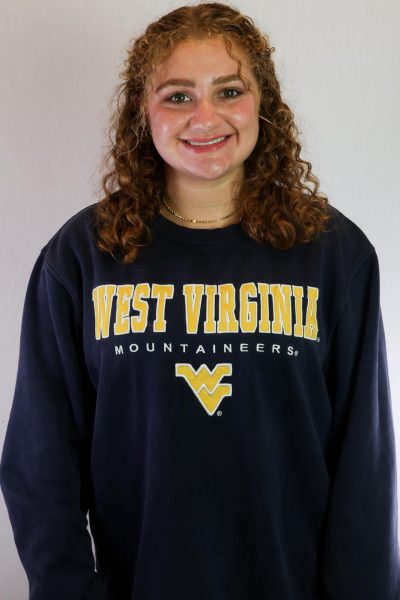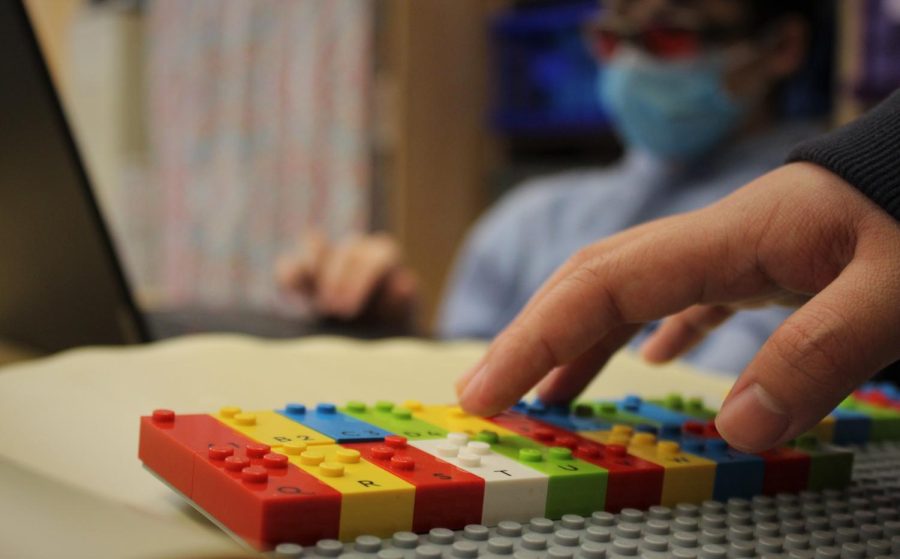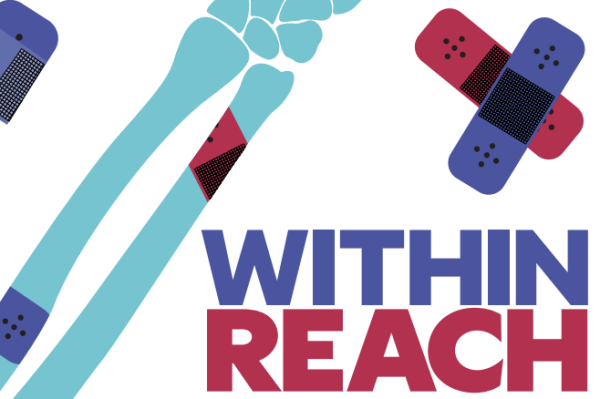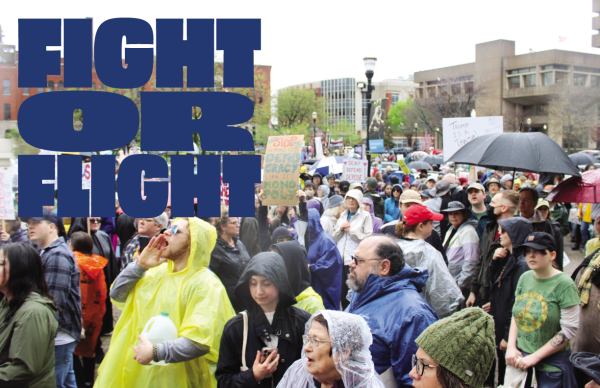Sense Of Self
The Kentucky School for the Blind empowers its students to become more independent.
Photos by Bella
In Ms. Spies classroom on Nov. 3, Whitney Nguyen moves her hand across braille Lego blocks in a demonstration of how they’re used. The raised tactile dots on the Legos spell out various braille letters to help teach the braille alphabet to students, teachers, and visitors at the Kentucky school for the blind. Photo by Bella Tilford.
“I’m a little more satisfied. I’m still not that good.”
On Nov. 3, sixteen-year-old Hayden Ashley’s fingers fumbled as he attempted to quicken his typing, silence lingering in the air as the rest of the class sat with bated breath, waiting for Ashley to complete his task. The student to his right twirled a pencil between his fingers, the next page of the lesson lying blank on the table in front of him.
Ashley bounced up and down in his seat, balancing delicately on the exercise ball. His hands skittered back and forth on the braille typewriter. Eyes fixed on the table, his fingers paused on the keys. He brought his hand up to scratch his head in confusion before putting it back down to create a new line of braille.
After adjusting the placement of the paper, his hands fluttered around his body, tugging the collar and returning to his task. Unsteady fingers skimmed the paper and scrambled for the keys, eventually gripping the paper, yanking it out of the typewriter, and tossing it onto the wooden table.
Ashley is one of the many students to attend the Kentucky School for the Blind (KSB), learning ways to live with his visual impairment.
Recognized as the third oldest blind school in the nation, KSB has been a hub for visually impaired students aged pre-K to 21 since 1842. That year marks the official start of KSB, but the school’s roots were solidified even before it became a state-approved building.
Bryce Patten, the school’s founder, began teaching a class of six blind students in the summer of 1839. Driven by his desire to initiate a school for the blind, Patten, with the help of his brother Otis Patten, appeared before the Kentucky General Assembly with a presentation of his students’ work. Despite this effort, funding was rejected.
It wasn’t until the brothers met Dr. Samuel Gridley Howe of the Massachusetts Institute for the Blind that they were able to produce a convincing presentation for the Kentucky Legislature. Soon thereafter, with a $10,000 grant, KSB officially opened in May of 1842 on Sixth Street in downtown Louisville. One outgrown building and one burned-down building later, they wound up situated on Frankfort Avenue by 1855, which is where the school is located today.
Contrary to public school systems like JCPS, KSB offers a specialized curriculum catered to the individual needs of their 62 students.
“Teachers here have to make accommodations and think of how to teach in a different way and how to make things tactile so that the kids can learn better,” said Christi Unker, the school’s librarian.
Despite their small student population, the community is filled with diversity.
From the Bluegrass region of Fayette County to the fertile farmlands of Tennessee, students arrive with different backgrounds and baggage, seeking a place to be seen. Some students arrive having borne the scars of gun violence, some having experienced their sight slowly diminish over time, while others simply attend in search of a community that other schools couldn’t provide for them.
“They help a lot. They understand what I’m trying to say, because I’m really bad at—I’m really bad at giving myself out. But somehow they understand what I’m trying to say,” said 16-year-old Brandon Marini.
This understanding is integral for the students, teachers, and staff at KSB. Along with a variety of backgrounds, the learning environment of each student is unique due to the different eye conditions they experience. KSB accommodates these differences by altering the physical environments of their classrooms.
Adam Stockhausen is the high school science teacher at KSB. In his sophomore class, the lights were off. Only a pinch of light could be seen in the corner of the classroom, illuminating two hands gliding softly along a piece of paper.
“Some of them are very light sensitive and so we have to have the lights off or the lights dimmer, or they have issues with glare,” Mr. Stockhausen said. “Other students need a lot more light so that they can actually see what’s in front of them.”
One of the three students in his classroom has a condition called aniridia, which means they have no irises. When Mr. Stockhausen said this, the student remained unaffected, raising two fists in the air and proudly claiming them as “black holes!”
The student in the corner of the classroom had a lamp perched beside him, the yellow glow spotlighting the braille-imprinted paper below his hands. He had a pair of red-lensed glasses on and was inching closer and closer to the paper with every line he traced.
“I only have one eye,” he grumbled.
“You’re still a full person despite only having one eye,” Mr. Stockhausen reassured him.
There are also students with detached retinas, optic nerve atrophy, full or partial color-blindness, and even degenerative diseases like retinitis pigmentosa—which means their vision is slowly narrowing—just to name a few.
Some may assume that all of the students at KSB are fully blind, but this isn’t the case. Most of the students actually have visual impairments, with only a select few being partially or fully blind. But what’s the difference?
Visual impairments are characterized by a severe loss in vision that cannot be fixed by methods such as contacts or glasses, as opposed to being fully blind.
Because of this, KSB spares no expense in assisting each and every student with their variety of needs.
“They try and make everyone feel included, honestly. There’s nothing we have that others don’t,” said 18-year-old student Mickie Foard.
If anything, they have more.
Vincent Reese stood in front of the SMART Board, dark lines of text contrasting against the bright white background. But none of the students were looking at the screen.
Each person was looking down at their own device. Occupying the attention of each student were BrailleNote Touches (a device similar to an iPad that has a refreshable braille display), braille typewriters, and laptops. They were all using different mediums to follow along with Mr. Reese’s lesson on presidential succession.
“Hilary Clinton was campaigning since…”
“2016!” one student eagerly said.
“Yes, 2016,” Mr. Reese affirmed.
When the lesson switched to Air Force trips, a student jokingly poked fun at Mr. Reese.
“It could be your retirement trip!”
The variety of devices wasn’t the only difference about KSB’s high school classes.
The students usually jump in on class discussion at any time, transforming what could be a lecture into a conversation.
In Sondra Miller’s freshman math classroom, a variety of unfamiliar tools and gadgets were packed inside office-like shelves. There were talking calculators, graphing boards with scratchy paper that produced puffed-up shapes, and even Braille Legos. In the corner of the classroom was what appeared to be a printer, but was in fact a machine called a Braille embosser, which creates raised designs on paper and prints braille.
The three students in her classroom, like the ones in Mr. Reese’s, were all using different devices to solve their math problems. They worked independently, with Ms. Miller occasionally offering a guiding hand.
Many students go to KSB through the Short Course Program (can also be referred to as the short term program), a nationally acknowledged outreach program that offers students the chance to receive direct instruction specialized for their visual impairments. The Short Course program offers up to 12 weeks in a school year, focusing Expanded Core Curriculum (ECC), which combines average education standards with additional skill sets to help visually impaired students navigate the world around them.
The Short Course Program is an opportunity for kids from various districts to stay in the KSB dorms and gain additional skills such as learning braille, dealing with daily living responsibilities, and social and technological abilities. Principal Peggy Sinclair-Morris described a feeling she witnessed in students that participated in the Short Course program: nostalgia.
“They definitely build this networking community,” she said.
This community flourishes among the students each and every day. Struggles and daily frustrations are common occurrences at KSB, but the students help each other overcome them, their shared experiences making those bonds even stronger. Mr. Stockhausen has personally witnessed instances of students offering help to one another. He said they know when to ask:
“‘Hey buddy, do you need assistance with this? Do you want me to guide you over here? Here, let me help you work with this! Do you want to take a turn doing this thing?’ They step up to that and they actively are trying to include everyone together,” he said.
Such interactions are part of what makes KSB so remarkable. Instead of being isolated for their differences, students are connected because of them.
“This is a special place just because the kiddos—they’re very kind to one another, they’re all in the same boat,” Ms. Unker said.
Community isn’t built solely on the backs of the students and their interactions with one another. Mr. Stockhausen and some of his colleagues recalled times when the students aided not only their peers, but teachers and staff as well.
High school English teacher Becky Spies described some of the difficulties she faced when she started at KSB and how the students aided her along the way.
“It was like, you jump in the fire and you do the best you can,” Ms. Spies said.
A few of Ms. Spies’ students admitted to knowing she was clueless, but did their best to guide and teach her by telling her what they needed in order to be successful.
For many of the teachers at KSB, who formerly taught at traditional public schools, the transition to a blind school wasn’t simple.
Mr. Stockhausen, Ms. Spies, and Ms. Miller had previously taught at Oldham County High School, with no prior experience teaching visually impaired students. In order to teach at KSB, all three were required to complete a two-year master’s program with the University of Kentucky. However, they didn’t start this program until after a couple of months teaching at KSB.
This introduced challenges for the teachers as they had no choice but to navigate new positions without any prior knowledge. This forced them to confront some of their assumptions and misconceptions about what kind of world they were stepping into.
“I thought that at a blind school, all the kids were blind and that was totally wrong. I
thought all of them had no vision and that’s almost the opposite,” Ms. Spies said.
Ms. Miller admitted to the same assumption.
“I was in that same category of not understanding all of the eye conditions and considering low vision and other things being part of a blind school,” she said.
Not only did they clarify some of their own misconceptions, they also emphasized on KSB’s goal.
“Even if they don’t have content necessarily mastered, the main goal is: Can they figure out how to be people out in the real world?” Mr. Stockhausen said.
Unfortunately, people tend to take advantage of these youth once they enter the real world. Their impairments are viewed as aspects of their being that make them vulnerable, but KSB does its best to prepare the students for instances in which this occurs.
“There have been a couple times that someone tried to short change me at a gas station and I counted it up and I told ’em, ‘That’s not right,’” said 15-year-old Eric Holden.
Holden has attended KSB since he was in kindergarten. When he was a toddler, he fell in his grandparent’s yard and detached the retina in his right eye, which caused him to lose vision. A few months later, his younger sister accidentally broke his glasses, causing glass to cut the cornea in the same eye. Various surgeries later, his doctors decided it would be best to remove the eye. Now, Holden has only his left eye, where less than half of his vision remains.
“Just don’t judge a book by it’s cover. Don’t just assume somebody is gonna have trouble doing something just because they’re blind or they have trouble seeing or they have a cane. They can still do pretty much just anything you can,” Holden said.
These assumptions can run through the students’ families as well.
“I love both my parents, but sometimes they can be a bit too much,” Foard admitted.
Even though Foard is an adult, her parents are still vigilant with her. She understands the reasoning, but wishes she had more freedom to do simple things like book her own doctor’s appointments. It’s not possible to always keep her sheltered from the uglier parts of the world.
“But sometimes people will take it a little bit too far and wave their hand at my face and be like, ‘How many fingers am I holding up?’ I can’t see your fingers. I can see your hand but not your fingers,” she said.
While there are people who approach her with bad intentions, there are also people who simply don’t understand.
“I mean, it’s great that they ask about it, but sometimes — sometimes they say stuff that hurts. Like maybe not intentionally, but it’s still there.”
It’s important to utilize proper etiquette when communicating with people that are visually impaired or blind. Certain interactions may seem helpful, but wind up being offensive or unnecessary. It is essential to communicate boundaries and keep from taunting people who are visually impaired or blind in ways similar to the one Foard described.
Some of Foard’s concerns are more practical, too.
“I’m also concerned about getting a job because sometimes people are a bit anxious about hiring blind people. They’re like, ‘What if they can’t do this? What if they can’t do that?’ You know how people are, they wouldn’t know how to help. They get closed off. They push people away,” she said.
Luckily, KSB offers many programs focused on addressing these concerns. One of them being the Work Program, where students are given an opportunity to work at various jobs and get paid through the Office of Vocational Rehabilitation (OVR). Foard spends her afternoons at the Kentucky School for the Blind Charitable Foundation, a non-profit whose primary purpose is to fund KSB’s outreach services, writing articles and drawing Christmas cards around the holidays. Students can also work at restaurants like J. Gumbo’s and establishments like the American Printing House, which neighbors KSB. The Work Program is free and students participate in it during their school days. In Foard’s case, she has work during her third and fourth period and then returns to her English class. At the end of the day, Foard heads back to her dorm, where she lives for free on campus.
Independent living is another program that KSB offers in which students live by themselves in the campus dorms. They learn how to buy groceries, budget, cook, and clean up after themselves. This prepares students for their adult life living by themselves, as well as for college and living in dorms alongside their peers.
Included in the ECC are Orientation and Mobility (O&M) skills, which help students navigate the real world alongside sighted people. This includes things like how to cross the street, ride the bus, request assistance, and use white canes to help them navigate their surroundings. The school also offers other classes focused on career preparation and basic daily skills, such as cooking or unclogging a toilet.
Some students even have the opportunity to split their time between classes at Central High School and KSB.
One of these students is 14-year-old Landon Smith. He wears glasses to aid his color blindness and light sensitivity by blocking out light. He usually spends about two or three periods at Central High School before riding the bus to KSB and finishing up the rest of his day.
“Everybody at Central likes me quite a bit,” Smith said, with a shy smile on his face.
While switching between a public school and a blind school works for Smith, it doesn’t necessarily work for others.
“I went to Central for the first part of the year. I don’t really like it very much, but I
did get some of that public school experience,” Holden said.
Holden also participates in the ECC, where he has learned many foundational skills such as O&M skills to help navigate the real world.
“Different ways we’re being more independent and self-advocating are one of the things they really emphasize,” Holden said.
Self-advocating plays a major role in how KSB prepares its students for life outside of school. Teachers and staff promote it as much as possible, encouraging students to ask for help when it is necessary.
“I don’t do a lot of hand-holding,” Ms. Spies said.
Self-advocating is necessary for the students in order to have their needs met later in life, when they aren’t in an environment that is catered towards their condition or filled with people that know what they need.
In many cases, KSB has been successful.
“It brought out more of my advocacy. Like if I have to have something I ask for it. Sometimes when I remember when I was younger, I would not ask for anything,” Foard said.
This success has also been seen in graduates of KSB.
In the summer of 2018, Ms. Unker and her daughter were seated outside of Five Guys, enjoying burgers, when a Lyft pulled up to the curb. The door of the car swung open and a white cane could be seen skimming along the pavement. Then, out stepped a former KSB student and his girlfriend.
Another customer shouted out, alerting the pair of an open seat.
Ms. Unker recognized the student and his girlfriend, who are both completely blind. She waited until they were seated to walk up to them, engaging in a conversation in which she discovered that the two had just returned from a trip to Europe.
“And I was like, ‘Yes! A trip to Europe! And you just took a Lyft and came here to eat independently and confidently.’ And that’s what it’s all about. That made me just be like, yes. You know, I had a tiny part of that,” Ms. Unker said.
It’s small moments like those that leave the biggest impact on the staff. It’s exactly what KSB wants their students to experience when they graduate:
Empowerment. Independence. Freedom.
“I just wish people would include more people via color blindness, any disability, any culture differences. Just be more accepting,” Foard said.
For much of the youth at KSB, acceptance was a long journey. Even now, there are days where acceptance is hard to grasp.
Foard discussed a trip she and her family took to the beach where the waves were too rough to get in the water.
“But my brother was like ‘watching the ocean is boring!’ I’m like, ‘at least you can see the waves. I can’t see the waves.’ It makes me sad,” she said.
Other times, acceptance comes in the form of gratitude.
“And sometimes I’m grateful for it because sometimes just the world can be cruel and I’m afraid of seeing what that’s like,” she said, her voice lowering as she admitted her fears.
While Foard has accepted her visual impairment through gratitude, Marini has accepted his through perseverance.
“How did I accept it? It’s because everyone’s different. Everyone is different. Life will get hard, but life will get better in the long run if you accept all the pain that has happened,” Marini said.
Acceptance has made progress in improving the students’ confidence and how they address ignorance.
“Blindness is a spectrum,” Foard said.
It isn’t just black and white. KSB has built a community that accepts all blind and visually-impaired students in every way they exist.
“It’s helped me realize that I’m not alone in the world, that there are other people, maybe not like me, but like me if that makes sense,” she said.
This is the community that KSB has always aimed to create and nurture.
“You know, ultimately I just wanna make sure that we’re doing the right thing for the kids here,” Dr. Sinclair-Morris said.
KSB’s entire vision statement is centered around empowerment and independence.
Empowering Students who are Blind and Visually Impaired to Command their Future.
With the many obstacles and challenges that blind and visually impaired youth go through, KSB curates an environment that uplifts their students, while equipping them with the tools in order to succeed in life. The reality is that blind and visually impaired students will have to pave their own paths because not every building that they walk into will be accommodating to their needs. Not every person will be as open-minded or as conscious as the staff at KSB. Not every door they open will provide them opportunities.
In this way, KSB acts as a guiding hand, steering the wheel until their students can steer it themselves. Until their students can walk into the real world and navigate it themselves. Until their students can form relationships themselves. Until their students can open doors for themselves. Their goal is to help students get to that place of independence.
A hand covered Hayden Ashley’s, aiding him in finding the line of braille.
“I promise you. You are improving so much. I’m so proud of you,” said Pam Cox, his braille teacher.
She spoke close to his ear, voice hushed as her lips lifted, smiling through her words. She removed her hand from where it had been resting on top of his, leaving Ashley to complete the line by himself.
Ashley paused, his head lowering as his hands flattened on the typewriter. One, two, three seconds passed before Ms. Cox urged him to complete the next line. He lifted his head, resolved, as he finished the last line.
On his own.
Donations are collected through The Publishers, duPont Manual High School's booster club for J&C. On The Record relies completely on sponsorships, advertisements, and donations to produce and distribute each issue. Please consider donating to our cause, and helping the student journalists of OTR amplify youth voices for years to come.

Kendall Geller is a senior and the Copy Editor for On the Record. This is her third year on staff and she is excited to work with all of the new writers...








